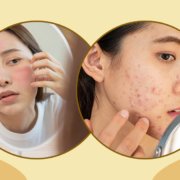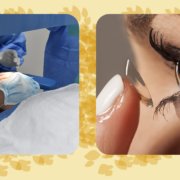What is skin purging?
Before we dive into explaining skin purging vs. skin breakouts and how to tell the difference, you need to understand what skin purging actually is.
Skin purging is effectively your usual skin replenishment process sped up. It happens as a reaction to certain active ingredients in skin care products and, whilst it can be unsettling, it’s not a bad thing! The new active ingredient encourages faster skin cell turnover and your skin starts to shed the dead skin cells more rapidly than usual. Ultimately this is good news: you’ll end up revealing fresher, younger-looking skin.
The thing is that during this process, potentially spot-inducing parts of the skin recycling process get drawn to the surface too. Sebum, build-up, and flakes all rise to the surface. As is likely to happen when there’s a party of these guys going on, pimples and spots breakout. Your skin is purging itself. It’s getting clean. But in the process, you’ve got to go via a messier stage.
Knowing if something is a skin purge or breakout can be tricky, not least because a purge can look very like a breakout at first glance. It’s characterized by blackheads, whiteheads, pustules, and… you get the idea. Just to make things really spectacular, it may also be accompanied by dry skin too.
Skin purging is often caused by chemical exfoliants and ingredients such as niacinamide (vitamin B3). We are using niacinamide in our night cream, and if we thought it would leave you with breakouts we obviously wouldn’t use it!
However, whilst niacinamide may cause a purge in some people, ultimately it reduces inflammation and minimizes pore size over time. But in the short term, that means it needs to do some clearing out!
Anything that loosens up deep-level congestion in the skin has the potential to cause a purge.
How can you tell if it’s a skin purge or breakout?
It’s one thing knowing that you’ve got to go through some short-term pain (the pimples) for some long-term gain (calm, clear, youthful-looking skin). It’s another feeling like you’re suddenly 15 again and heading for breakout hell. So when it comes to skin purging vs. skin breakouts, how do you know what’s what?
The first and easiest question to ask yourself is: are you using a new skincare product or doing something different with your skincare routine? If the answer is ‘yes’ then a purge is likely. However, many people think that the purge equals a breakout and therefore think their skin is reactive to this new product, and as such end up chucking it out. That’s a mistake with purging. You want to get to the other side!
Secondly, purging has some tell-tale signs that can help you feel confident that you’re not heading down breakout alley. Purges tend to be quite short-lived, or at least relatively so. They tend to clear up quite quickly without you really doing anything at all. The spots will also be occurring in the same old places you’ve always been prone to them. If you’re having a reaction to a new product then typically you’ll find that any spots that appear aren’t in the usual places.
It is really quite common for the introduction of a new product or new element of your routine to lead to some degree of purging. You can actually take it as good news; you can see that the product is doing something. The risk of purging is also why sometimes it can be good to introduce new skincare products gradually, allowing your skin to adjust over time.
How long will a skin purge last?
It is recommended unless you are clearly experiencing irritation, that it’s worth giving any new skincare product a month to see if it is working for you and to see if your skin will adjust. You need consistency, across a full cycle of skin replenishment, to see if it is working. A month is long enough for this full cycle, and all dead skin cells will definitely be shed at this time.
Some people find that it may take up to six weeks for their skin to fully adjust, but others find it takes considerably less time.
For more expert takes on your skin, consult our dermatologists!
Call our Patient Care Lines: (+632) 7-368 5238 l (+63) 917 862 7454 l (+63) 921 217 0517 for inquiries, questions, and appointments or talk to our consultants via LiveChat here on our website.






